Transport
This article needs additional citations for verification. (March 2020) |
| Part of a series on |
| Transport |
|---|
| Modes |
| Topics |
|
|
Transport (in
Transport infrastructure consists of both fixed installations, including
Modes

A mode of transport is a solution that makes use of a certain type of vehicle, infrastructure, and operation. The transport of a person or of cargo may involve one mode or several of the modes, with the latter case being called inter-modal or multi-modal transport. Each mode has its own advantages and disadvantages, and will be chosen on the basis of cost, capability, and route.
Governments deal with the way the vehicles are operated, and the procedures set for this purpose, including financing, legalities, and policies. In the transport industry, operations and ownership of infrastructure can be either public or private, depending on the country and mode.
Passenger transport may be public, where operators provide scheduled services, or private. Freight transport has become focused on containerization, although bulk transport is used for large volumes of durable items. Transport plays an important part in economic growth and globalization, but most types cause air pollution and use large amounts of land. While it is heavily subsidized by governments, good planning of transport is essential to make traffic flow and restrain urban sprawl.
Human-powered

Human-powered transport, a form of
Although humans are able to walk without infrastructure, the transport can be enhanced through the use of roads, especially when using the human power with vehicles, such as
Animal-powered
Animal-powered transport is the use of working animals for the movement of people and commodities. Humans may ride some of the animals directly, use them as pack animals for carrying goods, or harness them, alone or in teams, to pull sleds or wheeled vehicles.
Air
A
Two things necessary for aircraft are air flow over the wings for lift and an area for landing. The majority of aircraft also need an airport with the infrastructure for maintenance, restocking, and refueling and for the loading and unloading of crew, cargo, and passengers.[1] While the vast majority of aircraft land and take off on land, some are capable of take-off and landing on ice, snow, and calm water.
The aircraft is the second fastest method of transport, after the rocket. Commercial jets can reach up to 955 kilometres per hour (593 mph), single-engine aircraft 555 kilometres per hour (345 mph). Aviation is able to quickly transport people and limited amounts of cargo over longer distances, but incurs high costs and energy use; for short distances or in inaccessible places, helicopters can be used.[2] As of April 28, 2009, The Guardian article notes that "the WHO estimates that up to 500,000 people are on planes at any time."[3]
Land
Land transport covers all land-based transport systems that provide for the movement of people, goods, and services. Land transport plays a vital role in linking communities to each other. Land transport is a key factor in urban planning. It consists of two kinds, rail and road.
Rail
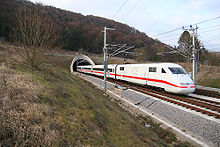

Rail transport is where a train runs along a set of two parallel
A train consists of one or more connected vehicles that operate on the rails. Propulsion is commonly provided by a
Road
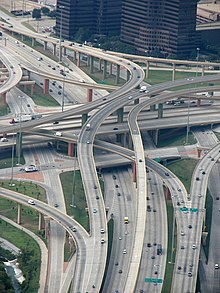
A road is an identifiable
The most common road vehicle is the automobile; a
Automobiles provide high flexibility with low capacity, but require high energy and area use, and are the main source of harmful noise and air pollution in cities;[9] buses allow for more efficient travel at the cost of reduced flexibility.[4] Road transport by truck is often the initial and final stage of freight transport.
Water
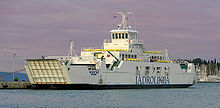
Water transport is movement by means of a watercraft—such as a barge, boat, ship, or sailboat—over a body of water, such as a sea, ocean, lake, canal, or river. The need for buoyancy is common to watercraft, making the hull a dominant aspect of its construction, maintenance, and appearance.
In the 19th century, the first
Although it is slow compared to other transport, modern
Other modes
Cable transport is a broad mode where vehicles are pulled by cables instead of an internal power source. It is most commonly used at steep gradient. Typical solutions include aerial tramways, elevators, and ski lifts; some of these are also categorized as conveyor transport.
Elements
Infrastructure
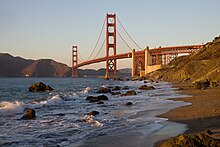

Infrastructure is the fixed installations that allow a vehicle to operate. It consists of a roadway, a terminal, and facilities for parking and maintenance. For rail, pipeline, road, and cable transport, the entire way the vehicle travels must be constructed. Air and watercraft are able to avoid this, since the airway and seaway do not need to be constructed. However, they require fixed infrastructure at terminals.
Terminals such as airports, ports, and stations, are locations where passengers and freight can be transferred from one vehicle or mode to another. For passenger transport, terminals are integrating different modes to allow riders, who are interchanging between modes, to take advantage of each mode's benefits. For instance, airport rail links connect airports to the city centres and suburbs. The terminals for automobiles are parking lots, while buses and coaches can operate from simple stops.[14] For freight, terminals act as transshipment points, though some cargo is transported directly from the point of production to the point of use.
The
Means of transport
Animals
Animals used in transportation include
Vehicles

A vehicle is a non-living device that is used to move people and goods. Unlike the infrastructure, the vehicle moves along with the cargo and riders. Unless being pulled/pushed by a cable or muscle-power, the vehicle must provide its own propulsion; this is most commonly done through a steam engine, combustion engine, electric motor, jet engine, or rocket, though other means of propulsion also exist. Vehicles also need a system of converting the energy into movement; this is most commonly done through wheels, propellers, and pressure.
Vehicles are most commonly staffed by a driver. However, some systems, such as people movers and some rapid transits, are fully automated. For passenger transport, the vehicle must have a compartment, seat, or platform for the passengers. Simple vehicles, such as automobiles, bicycles, or simple aircraft, may have one of the passengers as a driver. Recently, the progress related to the Fourth Industrial Revolution has brought a lot of new emerging technologies for transportation and automotive fields such as Connected Vehicles and Autonomous Driving. These innovations are said to form future mobility, but concerns remain on safety and cybersecurity, particularly concerning connected and autonomous mobility.[16]
Operation

Private transport is only subject to the owner of the vehicle, who operates the vehicle themselves. For public transport and freight transport, operations are done through
Policy
This section is missing information about most of what constitutes official traffic management and planning, how it integrates with other fields of politics and how it is enforced. (December 2021) |
As the population of the world increases, cities grow in size and population—according to the United Nations, 55% of the world's population live in cities, and by 2050 this number is expected to rise to 68%.[19] Public transport policy must evolve to meet the changing priorities of the urban world.[20] The institution of policy enforces order in transport, which is by nature chaotic as people attempt to travel from one place to another as fast as possible. This policy helps to reduce accidents and save lives.
Functions
Relocation of travelers and cargo are the most common uses of transport. However, other uses exist, such as the strategic and tactical
Passenger
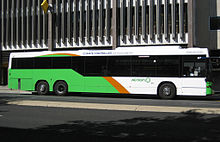
Passenger transport, or travel, is divided into public and private transport. Public transport is scheduled services on fixed routes, while private is vehicles that provide ad hoc services at the riders desire. The latter offers better flexibility, but has lower capacity and a higher environmental impact. Travel may be as part of daily commuting or for business, leisure, or migration.
Short-haul transport is dominated by the automobile and mass transit. The latter consists of
Taxis and buses can be found on both ends of the public transport spectrum. Buses are the cheapest mode of transport but are not necessarily flexible, and taxis are very flexible but more expensive. In the middle is demand-responsive transport, offering flexibility whilst remaining affordable.
Medical
Air medical services is a comprehensive term covering the use of air transport to move patients to and from healthcare facilities and accident scenes. Personnel provide comprehensive prehospital and emergency and critical care to all types of patients during aeromedical evacuation or rescue operations, aboard helicopters, propeller aircraft, or jet aircraft.[22][23]
Freight
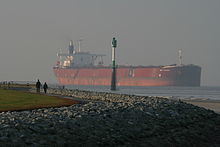
Freight transport, or shipping, is a key in the

Industry
Impact
Economic
Transport is a key necessity for
Due to the way modern cities and communities are planned and operated, a physical distinction between home and work is usually created, forcing people to transport themselves to places of work, study, or leisure, as well as to temporarily relocate for other daily activities. Passenger transport is also the essence of tourism, a major part of recreational transport. Commerce requires the transport of people to conduct business, either to allow face-to-face communication for important decisions or to move specialists from their regular place of work to sites where they are needed.
In lean thinking, transporting materials or work in process from one location to another is seen as one of the seven wastes (Japanese term: muda) which do not add value to a product.[33]
Planning
Transport planning allows for high use and less impact regarding new infrastructure. Using models of
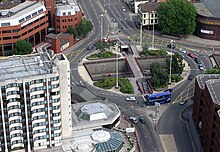
Because of the negative impacts incurred, transport often becomes the subject of controversy related to choice of mode, as well as increased capacity. Automotive transport can be seen as a tragedy of the commons, where the flexibility and comfort for the individual deteriorate the natural and urban environment for all. Density of development depends on mode of transport, with public transport allowing for better spatial use. Good land use keeps common activities close to people's homes and places higher-density development closer to transport lines and hubs, to minimize the need for transport. There are economies of agglomeration. Beyond transport, some land uses are more efficient when clustered. Transport facilities consume land, and in cities pavement (devoted to streets and parking) can easily exceed 20 percent of the total land use. An efficient transport system can reduce land waste.
Too much infrastructure and too much smoothing for maximum vehicle throughput mean that in many cities there is too much traffic and many—if not all—of the negative impacts that come with it. It is only in recent years that traditional practices have started to be questioned in many places; as a result of new types of analysis which bring in a much broader range of skills than those traditionally relied on—spanning such areas as environmental impact analysis, public health, sociology, and economics—the viability of the old mobility solutions is increasingly being questioned.
Environment
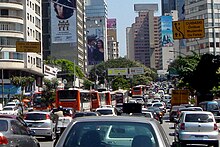
Transport is a major use of
Other environmental impacts of transport systems include
While
Airplane emissions change depending on the flight distance. It takes a lot of energy to take off and land, so longer flights are more efficient per mile traveled. However, longer flights naturally use more fuel in total. Short flights produce the most CO2 per passenger mile, while long flights produce slightly less.[43][44] Things get worse when planes fly high in the atmosphere.[45][46] Their emissions trap much more heat than those released at ground level. This isn't just because of CO2, but a mix of other greenhouse gases in the exhaust.[47][48] City buses produce about 0.3 kg of CO2 for every mile traveled per passenger. For long-distance bus trips (over 20 miles), that pollution drops to about 0.08 kg of CO2 per passenger mile.[49][50] On average, commuter trains produce around 0.17 kg of CO2 for each mile traveled per passenger. Long-distance trains are slightly higher at about 0.19 kg of CO2 per passenger mile.[51][52]>[53] The fleet emission average for delivery vans, trucks and big rigs is 10.17 kg (22.4 lb) CO2 per gallon of diesel consumed. Delivery vans and trucks average about 7.8 mpg (or 1.3 kg of CO2 per mile) while big rigs average about 5.3 mpg (or 1.92 kg of CO2 per mile).[54][55]
Sustainable development
The United Nations first formally recognized the role of transport in
There are various Sustainable Development Goals (SDGs) that are promoting sustainable transport to meet the defined goals. These include SDG 3 on health (increased road safety), SDG 7 on energy, SDG 8 on decent work and economic growth, SDG 9 on resilient infrastructure, SDG 11 on sustainable cities (access to transport and expanded public transport), SDG 12 on sustainable consumption and production (ending fossil fuel subsidies), and SDG 14 on oceans, seas, and marine resources.[57]
History

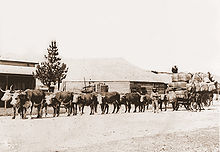
Natural
Humans' first ways to move included walking, running, and swimming. The domestication of animals introduced a new way to lay the burden of transport on more powerful creatures, allowing the hauling of heavier loads, or humans riding animals for greater speed and duration. Inventions such as the wheel and the sled (U.K. sledge) helped make animal transport more efficient through the introduction of vehicles.
The first forms of
Infrastructure
Many early civilizations, including those in
Water transport
Water transport, including rowed and sailed vessels, dates back to
Mechanical
Until the Industrial Revolution, transport remained slow and costly, and production and consumption gravitated as close to each other as feasible.[
With the development of the combustion engine and the automobile around 1900, road transport became more competitive again, and mechanical private transport originated. The first "modern" highways were constructed during the 19th century[citation needed] with macadam. Later, tarmac and concrete became the dominant paving materials.
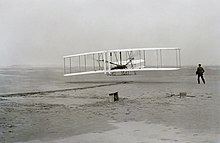
In 1903 the Wright brothers demonstrated the first successful controllable airplane, and after World War I (1914–1918) aircraft became a fast way to transport people and express goods over long distances.[59]
After World War II (1939–1945) the automobile and airlines took higher shares of transport, reducing rail and water to freight and short-haul passenger services.[60] Scientific spaceflight began in the 1950s, with rapid growth until the 1970s, when interest dwindled. In the 1950s the introduction of containerization gave massive efficiency gains in freight transport, fostering globalization.[30] International air travel became much more accessible in the 1960s with the commercialization of the jet engine. Along with the growth in automobiles and motorways, rail and water transport declined in relative importance. After the introduction of the Shinkansen in Japan in 1964, high-speed rail in Asia and Europe started attracting passengers on long-haul routes away from the airlines.[60]
Early in
See also
- Environmental impact of aviation
- Energy efficiency in transport
- Free public transport
- Green transport hierarchy
- IEEE Intelligent Transportation Systems Society
- List of emerging transportation technologies
- Journal of Transport and Land Use
- Outline of transport
- Personal rapid transit
- Public transport
- Rail transport by country
- Speed record
- Taxicabs by country
- Transportation engineering
References
- ^ Crawford, Amy (2021-10-25). "Could flying electric 'air taxis' help fix urban transportation?". The Guardian. Archived from the original on 2021-11-19. Retrieved 2021-11-19.
- ^ Cooper & Shepherd 1998, p. 281.
- ^ Swine flu prompts EU warning on travel to US Archived 2015-09-26 at the Wayback Machine. The Guardian. April 28, 2009.
- ^ a b Cooper & Shepherd 1998, p. 279.
- ^ "Major Roads of the United States". United States Department of the Interior. 2006-03-13. Archived from the original on 13 April 2007. Retrieved 24 March 2007.
- ^ "Road Infrastructure Strategic Framework for South Africa". National Department of Transport (South Africa). Archived from the original on 27 September 2007. Retrieved 24 March 2007.
- ^ Lay 1992, pp. 6–7.
- ^ "What is the difference between a road and a street?". Word FAQ. Lexico Publishing Group. 2007. Archived from the original on 5 April 2007. Retrieved 24 March 2007.
- from the original on 2020-03-05. Retrieved 2020-03-05.
- ^ The United Nations Conference on Trade and Development (UNCTAD) 2007, pp. x, 32.
- ^ Stopford 1997, pp. 4–6.
- ^ Stopford 1997, pp. 8–9.
- ^ Cooper & Shepherd 1998, p. 280.
- ^ Cooper & Shepherd 1998, pp. 275–276.
- ^ Bent Flyvbjerg, Mette K. Skamris Holm, and Søren L. Buhl, "How (In)Accurate Are Demand Forecasts in Public Works Projects", Journal of the American Planning Association 71:2, pp. 131–146.
- ^ Hamid, Umar Zakir Abdul; et al. (2021). "Facilitating a Reliable, Feasible, and Comfortable Future Mobility". SAE International Journal of Connected and Automated Vehicles. 4 (1). Retrieved 5 September 2022.
- ^ Stopford 1997, p. 422.
- ^ Stopford 1997, p. 29.
- ^ Meredith, Sam (2018-05-17). "Two-thirds of global population will live in cities by 2050, UN says". CNBC. Archived from the original on 2020-11-12. Retrieved 2018-11-20.
- .
- ^ Skinner, Henry Alan. 1949, "The Origin of Medical Terms". Baltimore: Williams & Wilkins
- PMID 15928284.
- PMID 7832345.
- ^ Chopra & Meindl 2007, p. 3.
- ^ Chopra & Meindl 2007, pp. 63–64.
- from the original on 2022-07-30. Retrieved 2021-01-14.
- ^ Chopra & Meindl 2007, p. 54.
- ^ Bardi, Coyle & Novack 2006, p. 4.
- ^ Bardi, Coyle & Novack 2006, p. 473.
- ^ a b Bardi, Coyle & Novack 2006, pp. 211–214.
- ^ Chopra & Meindl 2007, p. 328.
- ^ Stopford 1997, p. 2.
- ^ EKU Online, The Seven Wastes of Lean Manufacturing Archived 2023-03-07 at the Wayback Machine, Eastern Kentucky University, accessed 6 March 2023
- ^ International Council on Clean Transportation, A world of thoughts on Phase 2 Archived 2018-11-19 at the Wayback Machine, 16 September 2016 (page visited on 18 November 2018).
- ^ (PDF) from the original on 2008-06-25. Retrieved 2008-01-14.
- ^ Worldwatch Institute (16 January 2008). "Analysis: Nano Hypocrisy?". Archived from the original on 13 October 2013. Retrieved 17 January 2008.
- (PDF) from the original on May 4, 2018. Retrieved November 20, 2018.
- ^ "Claverton-Energy.com". Claverton-Energy.com. 2009-02-17. Archived from the original on 2021-03-18. Retrieved 2010-05-23.
- ^ Data on the barriers and motivators to more sustainable transport behaviour is available in the UK Department for Transport study "Climate Change and Transport Choices Archived 2011-05-30 at the Wayback Machine" published in December 2010.
- Environment Canada. "Transportation". Archived from the originalon July 13, 2007. Retrieved 30 July 2008.
- ^ Planning (2020-09-09). "20-minute neighbourhoods". Planning. Archived from the original on 2021-09-20. Retrieved 2020-09-26.
- ^ "Congestion Charge (Official)". Transport for London. Archived from the original on 2021-03-09. Retrieved 2020-09-26.
- ^ "How We Calculate Your Carbon Footprint". Archived from the original on 2012-01-03. Retrieved 2011-12-29.
- ^ "[SafeClimate] measuring and reporting | tools". Archived from the original on 2008-03-27. Retrieved 2010-04-23.
- ISBN 978-0-521-55962-1.
- ISBN 978-1-315-29775-0.
- ^ Schumann, Ulrich (2011). "American Institute of Aeronautics and Astronautics: Potential to reduce the climate impact of aviation by flight level changes" (PDF). Retrieved 2022-06-30.
- ^ Lee D.S., Pitari G., Grewe V., Gierens K., Penner J.E., Petzold A., Prather M.J., Schumann U., Bais A., Berntsen T., Iachetti D., Lim L.L., Sausen R. (2010). Transport impacts on atmosphere and climate: Aviation. In – Atmospheric Environment Transport Impacts on Atmosphere and Climate: The ATTICA Assessment Report. 44:37:pp.4678-4734.
- ^ "Archived copy". Archived from the original on 2016-01-12. Retrieved 2010-04-23.
{{cite web}}: CS1 maint: archived copy as title (link) - ^ "How We Calculate Your Carbon Footprint". Archived from the original on 2012-01-03. Retrieved 2011-12-29.
- ^ "Archived copy". Archived from the original on 2016-01-12. Retrieved 2010-04-23.
{{cite web}}: CS1 maint: archived copy as title (link) - ^ "How We Calculate Your Carbon Footprint". Archived from the original on 2012-01-03. Retrieved 2011-12-29.
- ^ "'Dramatically more powerful': world's first battery-electric freight train unveiled". the Guardian. 2021-09-16. Retrieved 2021-09-21.
- ^ "403 - Forbidden: Access is denied" (PDF).
- ISSN 2156-2202.
- ^ "Sustainable transport". Sustainable Development Knowledge Platform. Archived from the original on 2020-10-09. Retrieved 2020-09-26.
- ^ "Sustainable transport at the heart of the Sustainable Development Goals (SDGs)". Sustainable Development Knowledge Platform. Archived from the original on 2020-10-15. Retrieved 2020-09-26.
- ^
Watts, Martin (1999). Working Oxen. Shire Album. Vol. 342. Princes Risborough, Buckinghamshire: Osprey Publishing. p. 4. ISBN 978-0747804154. Retrieved 2016-02-08.
[...] tamed aurochs became the first domestic oxen. The earliest evidence for domestication is found in the Middle East around ten thousand years ago.
- ^ Bardi, Coyle & Novack 2006, p. 158.
- ^ a b Cooper & Shepherd 1998, p. 277.
- ^ Clifford Winston, Last Exit: Privatization and Deregulation of the U.S. Transportation System (Washington, D.C.: Brookings Institution, 2010).
Bibliography
- Bardi, Edward; Coyle, John & Novack, Robert (2006). Management of Transportation. Australia: Thomson South-Western. OCLC 62259402.
- Chopra, Sunil & Meindl, Peter (2007). Supply chain management : strategy, planning, and operation (3rd ed.). Upper Saddle River, N.J.: Pearson. OCLC 63808135.
- Cooper, Christopher P.; Shepherd, Rebecca (1998). Tourism: Principles and Practice (2nd ed.). Harlow, England: Financial Times Prent. Int. OCLC 39945061. Retrieved 22 December 2012.
- Lay, Maxwell G (1992). Ways of the World: A History of the World's Roads and of the Vehicles that Used Them. New Brunswick, N.J.: Rutgers University Press. OCLC 804297312.
- Stopford, Martin (1997). Maritime Economics (2nd ed.). London: Routledge. OCLC 36824728.
Further reading
- at the moment." (p. 32.)
External links
- Transportation from UCB Libraries GovPubs
- Transportation at Curlie
- America On the Move Archived 2011-08-05 at the Wayback Machine An online transportation exhibition from the National Museum of American History, Smithsonian Institution
- World Transportation Organization The world transportation organization (The non-profit Advisory Organization)
